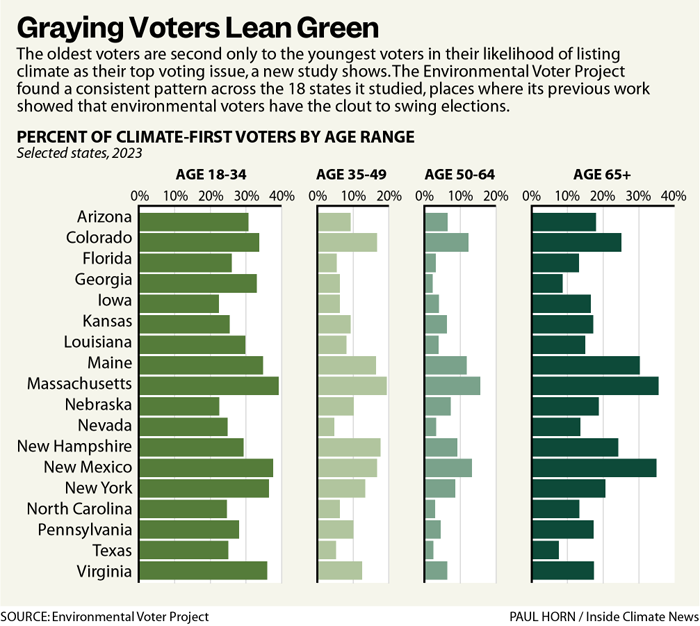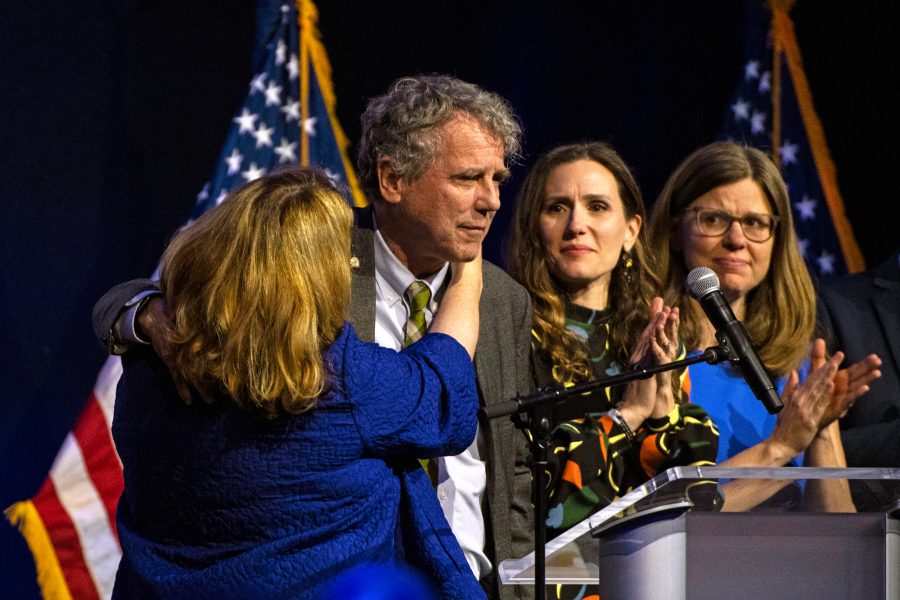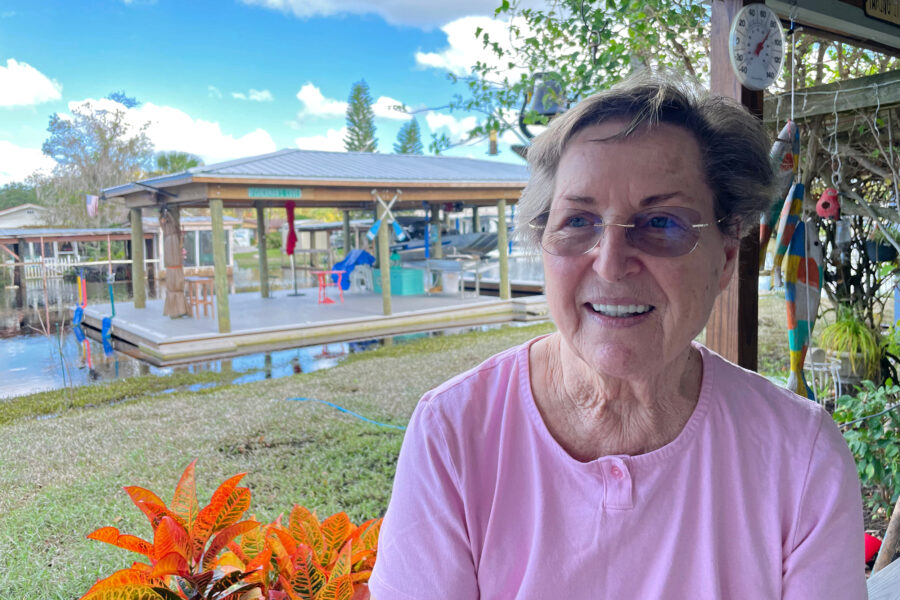Older Voters Are Second Only to Young People in Share of ’Climate Voters,’ New Study Shows
On the front line of the drive for U.S. political action on climate, the youth movement has had a largely unsung partner—one with more experience, greater resources and often, ample time to devote to the cause.
Voters aged 65 and older are second only to those between the ages of 18 and 34 in naming climate and the environment their highest political priorities, according to a new 18-state study by the Boston-based Environmental Voter Project, or EVP.
In some states, these graying green voters add up to a block with potential to swing elections. In New Mexico, for example, more than one-third of older voters prioritize climate, the data show. In Colorado, one in four senior citizens give climate top weight when going to the polls. And in Pennsylvania, a state President Joe Biden won by 1.2 percent, and Arizona, where his victory margin was 0.4 percent, climate voters aged 65 and up make up 5 percent of the electorate.
Put another way: EVP identified 230,000 climate voters 65 or older in Arizona, a state where the presidential race was decided by 10,500 votes in 2020.
“I think this data is a warning sign for politicians, because they know that older Americans vote, volunteer and donate at the highest levels,” said Nathaniel Stinnett, executive director of EVP. “And as they increasingly care about climate change, politicians better follow suit, or they’ll regret it on election day.”
“Painful to Watch it Disappear”
The findings come at a time when there has been a growing recognition of the role that senior citizens have been playing in the climate movement. This past spring, in what was billed as the first set of mass climate demonstrations by older Americans, protestors blockaded branches of banks that finance fossil fuel development in nearly 100 cities.
“It’s not just that people are concerned, it’s that they are more than willing to take action,” said author and climate activist Bill McKibben, who helped found the group Third Act, which organized the bank protests. The group, which turned 2 years old in September, now has more than 75,000 so-called “experienced Americans” who have volunteered to work on climate and other progressive campaigns.
McKibben, who with a group of college students in 2008 founded the youth-focused climate action group 350.org, said that while fear for their future is a driving force for younger climate activists, he sees a different motivation in older ones.
“It’s almost a small ‘c’ kind of conservatism,” he said. “They’re thinking, ‘I like the world that I was born into, a world with some ice on the top and the bottom and the odd coral reef in between, and it’s very painful to watch it disappear.’ And of course, there’s an extraordinary fear for one’s kids and grandkids.”
Of course, senior citizens have long been prominent voices in the climate movement. Former NASA scientist James Hansen, 82, continues to publish studies and speak out. In the United Kingdom, an 80-year-old retired Anglican priest, Rev. Sue Parfitt, has gained attention after being arrested repeatedly in Extinction Rebellion protests. Indian environmentalist Saalumarada Thimmakka, honored globally for her reforestation work, reportedly talked of her plans to plant more trees days after undergoing heart surgery this fall at the age of 112.

The EVP study shows that these extraordinary older activists are the tip of the iceberg, representing a much broader core group of older citizens passionate about climate. Across the 18 states that EVP studied, 16.4 percent of registered voters aged 65 and older were likely to consider either “climate change” or “clean air, clean water and the environment” as their top issue priority. Only voters aged 18 to 34, with 29.7 percent giving those issues top ranking, had a greater share of what EVP calls “climate-first voters.”
The results indicate that both the oldest and youngest age groups analyzed have a greater than average share of voters who give greater weight to climate than all other issues. When EVP has looked broadly at the population, such as in a July 2022 battleground state poll, it has found on average 8 to 10 percent of voters rank climate at the top of their list of concerns, Stinnett said. Other polls suggest the nationwide share of climate-first voters is even lower: Just 4 percent to 6 percent of registered voters ranked the environment as their top issue in polling conducted in U.S. swing states in October for The Telegraph newspaper in London.
While many recent surveys show that a majority of registered voters—close to 60 percent—support action on global warming, EVP aimed to understand the voters for whom climate truly is a decisive issue. For example, as Stinnett puts it, a majority of voters might support year-round daylight savings time, but it is doubtful that as many would list it as their motivating factor as a voter.
“It’s the salience of an issue that often determines who someone will vote for, and who ends up winning an election,” he said.
Identifying “climate-first” voters is important for EVP, which is a get-out-the-vote group. Instead of doing candidate advocacy, EVP uses Big Data and voter registration rolls to identify voters who are passionate about the environment and climate, and then make sure they get to the polls. In the course of that work, Stinnett said, the group noticed a consistent pattern of voters 65 and older falling into the “climate-first” category.
That’s when EVP decided to dig more deeply into older climate voters, and working with TargetSmart, a political data company, conducted a survey of more than 11,000 voters on their top issue priorities. They combined the results with other publicly available data to build predictive models identifying how likely each voter in 18 states is to list climate as a top voting priority. (EVP does not work in all 50 states, only in those where its research has shown environmental voters are likely to make a difference in elections.) Political campaigns typically use such predictive models to plan targeted messaging, using data gleaned from consumer purchasing information, magazine subscriptions, and other sources.
Some recent results from traditional polling bolster the findings of the EVP study. A November poll by Quinnipiac University showed that 6 percent of both the oldest voters and youngest voters said they saw climate change as the most urgent issue currently facing the country, about double the share for voters 50 to 64. (In that poll, both the economy and threats to democracy overwhelmingly topped all other issues across all age groups.)
And in an ecoAmerica survey conducted in July, 45 percent of voters 65 and older said they were “very concerned” about climate, more than in any other age category, including among voters aged 18 to 24 (39 percent.) But in that same survey, 19 percent of older voters said they were “not concerned at all” about climate—also more than any other age category. That pulled down the average, or the total number of “concerned voters” in the oldest category—a result that might lead politicians, in McKibben’s words, to “make the mistake of assuming they’re all Fox News viewers.”
In fact, Stinnett said, older Americans include both a large number of individuals who are passionate about climate and a large number who are dismissive.
“There aren’t many older people in the mushy middle on climate change,” he said.
Adding Senior Clout to Youth Enthusiasm
The presence of older climate-first voters will only become more important as their numbers grow. Globally, the population aged 60 years and over is expected to increase from 1 billion in 2020 to 1.4 billion by 2030, and to double to 2.1 billion by 2050, according to the World Health Organization.
Senior citizens have organized climate groups in the past, such as the nonpartisan U.S. group Elders Climate Action, founded in 2014; and Seniors for Climate Action Now!, or SCAN, founded in 2020 in Toronto. But McKibben said the climate movement as a whole has not made as much effort as it should to organize older activists.
He said older citizens are important climate allies for a host of reasons. They have a superior voting record, with 76 percent voter turnout in 2020 (compared to voters 18 to 24, with voter turnout at 51.4 percent.) Also, retirees have the time needed to devote to arcane but crucial tasks; McKibben noted some Third Act activists have spent long hours monitoring state Public Utility Commission meetings.
Older people also have networks of contacts they have made over the years, as well as the financial savings they have built up. About 70 percent of the financial assets in America belong to Baby Boomers (those born roughly from 1946 to 1964) and the Silent Generation (those born from 1925 to 1945), according to Third Act.
“We’ve correctly prioritized a lot of work building up youth movements around climate,” McKibben said. “I’ve been an active participant in all of that and I support it fully. But young people, for all of their intelligence and energy and idealism, lack the structural power—by themselves—to make the change we need in the time we have.”
Share this article
Disclaimer: The copyright of this article belongs to the original author. Reposting this article is solely for the purpose of information dissemination and does not constitute any investment advice. If there is any infringement, please contact us immediately. We will make corrections or deletions as necessary. Thank you.







